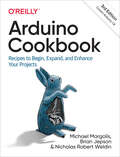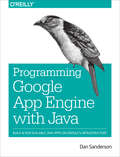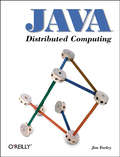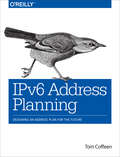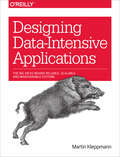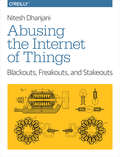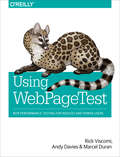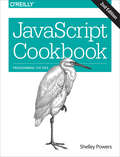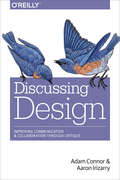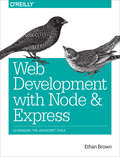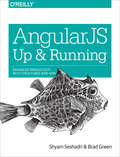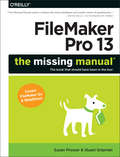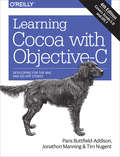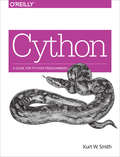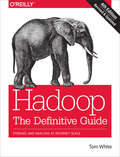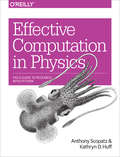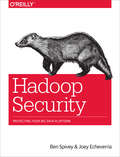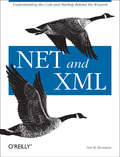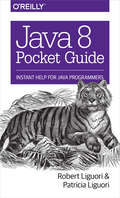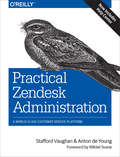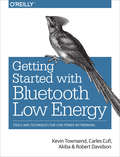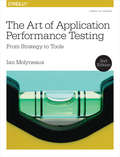- Table View
- List View
Arduino Cookbook: Recipes to Begin, Expand, and Enhance Your Projects (Oreilly And Associate Ser.)
by Brian Jepson Michael Margolis Nicholas Robert WeldinWant to create devices that interact with the physical world? This cookbook is perfect for anyone who wants to experiment with the popular Arduino microcontroller and programming environment. You’ll find more than 200 tips and techniques for building a variety of objects and prototypes such as IoT solutions, environmental monitors, location and position-aware systems, and products that can respond to touch, sound, heat, and light.Updated for the Arduino 1.8 release, the recipes in this third edition include practical examples and guidance to help you begin, expand, and enhance your projects right away—whether you’re an engineer, designer, artist, student, or hobbyist.Get up to speed on the Arduino board and essential software concepts quicklyLearn basic techniques for reading digital and analog signalsUse Arduino with a variety of popular input devices and sensorsDrive visual displays, generate sound, and control several types of motorsConnect Arduino to wired and wireless networksLearn techniques for handling time delays and time measurementApply advanced coding and memory-handling techniques
Programming Google App Engine with Java
by Dan SandersonThis practical guide shows intermediate and advanced web and mobile app developers how to build highly scalable Java applications in the cloud with Google App Engine. The flagship of Google's Cloud Platform, App Engine hosts your app on infrastructure that grows automatically with your traffic, minimizing up-front costs and accommodating unexpected visitors. You'll learn hands-on how to perform common development tasks with App Engine services and development tools, including deployment and maintenance.For Java applications, App Engine provides a J2EE standard servlet container with a complete Java 7 JVM and standard library. Because App Engine supports common Java API standards, your code stays clean and portable.Get a hands-on introduction to App Engine's tools and features, using an example applicationSimulate App Engine on your development machine directly from EclipseStructure your app into individually addressable modules, each with its own scaling configurationExploit the power of the scalable Cloud Datastore, using queries, transactions, and data modeling with JPAUse Cloud SQL for standard relational databases with App Engine applicationsLearn how to deploy, manage, and inspect your application on Google infrastructure
Java Distributed Computing (Java Series)
by Jim FarleyJava Distributed Computing offers a general introduction to distributed computing, meaning programs that run on two or more systems. It focuses primarily on how to structure and write distributed applications and discusses issues like designing protocols, security, working with databases, and dealing with low bandwidth situations.
IPv6 Address Planning
by Tom CoffeenIf you're ready to join the move to IPv6, this comprehensive guide gets you started by showing you how to create an effective IPv6 address plan. In three example-driven sections--preparation, design, and maintenance--you'll learn principles and best practices for designing, deploying, and maintaining an address plan far beyond what's possible with IPv4 networks.During the course of the book, you'll walk through the process of building a sample address plan for a fictional company. Enterprise IT network architects, engineers, and administrators will see firsthand how IPv6 provides opportunities for creating an operationally efficient plan that's scalable, flexible, extensible, manageable, and durable.Explore IPv6 addressing basics, including representation, structure, and typesManage risks and costs by using a three-phase approach for deploying IPv6Dig into IPv6 subnetting methods and learn how they differ from IPv4Determine the appropriate size and type of the IPv6 allocation you requireApply current network management tools to IPv6Use IPv6 renumbering methods that enable greater network scale and easier integrationImplement policies and practices to keep IPv6 addresses reachable
Designing Data-Intensive Applications: The Big Ideas Behind Reliable, Scalable, and Maintainable Systems
by Martin KleppmannData is at the center of many challenges in system design today. Difficult issues need to be figured out, such as scalability, consistency, reliability, efficiency, and maintainability. In addition, we have an overwhelming variety of tools, including NoSQL datastores, stream or batch processors, and message brokers. What are the right choices for your application? How do you make sense of all these buzzwords?In this practical and comprehensive guide, author Martin Kleppmann helps you navigate this diverse landscape by examining the pros and cons of various technologies for processing and storing data. Software keeps changing, but the fundamental principles remain the same. With this book, software engineers and architects will learn how to apply those ideas in practice, and how to make full use of data in modern applications.Peer under the hood of the systems you already use, and learn how to use and operate them more effectivelyMake informed decisions by identifying the strengths and weaknesses of different toolsNavigate the trade-offs around consistency, scalability, fault tolerance, and complexityUnderstand the distributed systems research upon which modern databases are builtPeek behind the scenes of major online services, and learn from their architecture
Abusing the Internet of Things: Blackouts, Freakouts, and Stakeouts
by Nitesh DhanjaniThe upcoming IoT age will blur the line between our physical and online lives. Attacks targeting our online spaces will put our physical security at risk. Traditionally, the attack vectors to our fundamental luxuries have required physical tampering, mostly because access to the infrastructure has been limited from the Internet. This is about to change with the upcoming disruption caused by a future with billions of "things" connected to the Internet.This book takes a fascinating look into abusing the most popular IoT-based devices already available in the market. You'll learn how a simple attack can cause a perpetual blackout targeting LED lightbulbs, how bad security decisions have grossly violated the physical safety and privacy of families, and how the insecurity of powerful electric vehicles can put your life at risk.The goal of this book is to demonstrate tangible risk in IoT devices that we're going to depend on more and more as time progresses. Once we begin to understand the cause of actual security vulnerabilities in devices today, we will begin to set the path for a future that will help us enable these devices to securely enhance and augment our lives.The stakes are high. Malicious attackers are already hard at work uncovering and exploiting these security defects and they will continue to find crafty avenues to abuse their knowledge every way they can. These attackers span the spectrum of curious college students to sophisticated private and state sponsored criminal gangs that are interested in terrorizing individuals and populations. The impact of security vulnerabilities in IoT devices can lead to mass compromise of privacy and cause physical harm.
Using WebPageTest
by Andy Davies Marcel Duran Rick ViscomiLearn basic and advanced uses of WebPagetest, the performance measurement tool for optimizing websites. This practical guide shows users new to this tool how run tests and interpret results, and helps experienced users gain a better and more thorough understanding of hidden features in WebPagetest that make testing easier.Written by WebPagetest power users and performance experts, this book will help web developers and frontend engineers solve the problem of slow sites. Topics include:Basic test setup--shows beginners how to get meaningful resultsAdvanced test setup--provides another level of technical depth by explaining features not thoroughly documented at webpagetest.orgAnalysis of results--helps you understand of how to interpret test resultsPrivate instance setup--teaches power users the intricacies of the webpagetest private instance and how it worksAPI and external tools--provides a detailed reference for the API and demonstrates tools already using the API to extend WebPagetest
JavaScript Cookbook
by Shelley PowersWhy reinvent the wheel every time you run into a problem with JavaScript? This cookbook is chock-full of code recipes that address common programming tasks, as well as techniques for building web apps that work in any browser. Just copy and paste the code samples into your project -- you'll get the job done faster and learn more about JavaScript in the process. You'll also learn how to take advantage of the latest features in ECMAScript 5 and HTML5, including the new cross-domain widget communication technique, HTML5's video and audio elements, and the drawing canvas. You'll find recipes for using these features with JavaScript to build high-quality application interfaces. Create interactive web and desktop applications Work with JavaScript objects, such as String, Array, Number, and Math Use JavaScript with Scalable Vector Graphics (SVG) and the canvas element Store data in various ways, from the simple to the complex Program the new HTML5 audio and video elements Implement concurrent programming with Web Workers Use and create jQuery plug-ins Use ARIA and JavaScript to create fully accessible rich internet applications
Discussing Design: Improving Communication and Collaboration through Critique
by Adam Connor Aaron IrizarryReal critique has become a lost skill among collaborative teams today. Critique is intended to help teams strengthen their designs, products, and services, rather than be used to assert authority or push agendas under the guise of "feedback." In this practical guide, authors Adam Connor and Aaron Irizarry teach you techniques, tools, and a framework for helping members of your design team give and receive critique.Using firsthand stories and lessons from prominent figures in the design community, this book examines the good, the bad, and the ugly of feedback. You'll come away with tips, actionable insights, activities, and a cheat sheet for practicing critique as a part of your collaborative process.This book covers:Best practices (and anti-patterns) for giving and receiving critiqueCultural aspects that influence your ability to critique constructivelyWhen, how much, and how often to use critique in the creative processFacilitation techniques for making critiques timely and more effectiveStrategies for dealing with difficult people and challenging situations
Web Development with Node and Express
by Ethan BrownThe Express web application framework for Node strikes the ideal balance between a robust framework and no framework at all. Many web frameworks try to do so much that they become inflexible and overly complicated, having a negative effect on both learning curve and ability to customize. Express takes a much more agnostic approach, allowing developers a free hand in their architecture choices. It is a joy to work with, and this book is designed not only to introduce the framework, but also to provide some guidance about how to go about doing things that more elaborate (and inflexible) frameworks provide.Even though there is plenty of material on the topic of Express alone, Web Development with Node and Express will provide you additional value because it also covers best practices in web architecture. Ideal for those new to JavaScript, this book also shows experienced JavaScript developers have started to look towards Express as a viable alternative for web development.As someone who deals every day with the complexities of real-world websites, author Ethan Brown offers tremendous wisdom and experience for people interested in producing high-quality, fast, maintainable websites that are friendly to SEO and analytics.This book covers Express 4.0.
AngularJS: Up and Running
by Brad Green Shyam SeshadriIf you want to get started with AngularJS, either as a side project, an additional tool, or for your main work, this practical guide teaches you how to use this meta-framework step-by-step, from the basics to advanced concepts. By the end of the book, you'll understand how to develop a large, maintainable, and performant application with AngularJS.Guided by two engineers who worked on AngularJS at Google, you'll learn the components needed to build data-driven applications, using declarative programming and the Model-view-controller pattern. You'll also learn how to conduct unit tests on each part of your application.Learn how to use controllers for moving data to and from viewsUnderstand when to use AngularJS services instead of controllersCommunicate with the server to store, fetch, and update data asynchronouslyKnow when to use AngularJS filters for converting data and values to different formatsImplement single-page applications, using ngRoute to select views and navigationDive into basic and advanced directives for creating reusable componentsWrite an end-to-end test on a live version of your entire applicationUse best practices, guidelines, and tools throughout the development cycle
FileMaker Pro 13: The Missing Manual
by Susan Prosser Stuart GripmanYou don’t need a technical background to build powerful databases with FileMaker Pro 13. This crystal-clear guide covers all new FileMaker Pro 13 features, such as its improved layout tools and enhanced mobile support. Whether you’re running a business, printing a catalog, or planning a wedding, you’ll learn how to customize your database to run on a PC, Mac, Web browser, or iOS device.The important stuff you need to know:Get started. Tour FileMaker Pro’s features and create your first database in minutes.Access data anywhere. Use FileMaker Go on your iPad or iPhone—or share data on the Web.Dive into relational data. Solve problems quickly by connecting and combining data tables.Create professional documents. Publish reports, invoices, catalogs, and other documents with ease.Harness processing power. Use calculations and scripts to crunch numbers, search text, and automate tasks.Add visual power and clarity. Create colorful charts to illustrate and summarize your data.Share your database on a secure server. Add the high-level features of FileMaker Pro Advanced and FileMaker Pro Server.
FileMaker Pro 12: The Missing Manual
by Susan Prosser Stuart Gripman<p>You don’t have to be a techie to use FileMaker Pro 12, but you do need to know what you’re doing. With this crystal-clear guide, you’ll learn how to create a powerful database that lets you do almost anything with your data. Whether you’re running a business, printing a catalog, or planning a wedding, you’ll learn how to customize your database and put it to work.</p>
Learning Cocoa with Objective-C
by Tim Nugent Jonathon Manning Paris Buttfield-AddisonGet up to speed on Cocoa and Objective-C, and start developing applications on the iOS and OS X platforms. If you don't have experience with Apple's developer tools, no problem! From object-oriented programming to storing app data in iCloud, the fourth edition of this book covers everything you need to build apps for the iPhone, iPad, and Mac.You'll learn how to work with the Xcode IDE, Objective-C's Foundation library, and other developer tools such as Event Kit framework and Core Animation. Along the way, you'll build example projects, including a simple Objective-C application, a custom view, a simple video player application, and an app that displays calendar events for the user.Learn the application lifecycle on OS X and iOSWork with the user-interface system in Cocoa and Cocoa TouchUse AV Foundation to display video and audioBuild apps that let users create, edit, and work with documentsStore data locally with the file system, or on the network with iCloudDisplay lists or collections of data with table views and collection viewsInteract with the outside world with Core Location and Core MotionUse blocks and operation queues for multiprocessing
Cython
by Kurt W. SmithBuild software that combines Python's expressivity with the performance and control of C (and C++). It's possible with Cython, the compiler and hybrid programming language used by foundational packages such as NumPy, and prominent in projects including Pandas, h5py, and scikits-learn. In this practical guide, you'll learn how to use Cython to improve Python's performance--up to 3000x-- and to wrap C and C++ libraries in Python with ease.Author Kurt Smith takes you through Cython's capabilities, with sample code and in-depth practice exercises. If you're just starting with Cython, or want to go deeper, you'll learn how this language is an essential part of any performance-oriented Python programmer's arsenal.Use Cython's static typing to speed up Python codeGain hands-on experience using Cython features to boost your numeric-heavy PythonCreate new types with Cython--and see how fast object-oriented programming in Python can beEffectively organize Cython code into separate modules and packages without sacrificing performanceUse Cython to give Pythonic interfaces to C and C++ librariesOptimize code with Cython's runtime and compile-time profiling toolsUse Cython's prange function to parallelize loops transparently with OpenMP
Hadoop: Storage and Analysis at Internet Scale
by Tom WhiteGet ready to unlock the power of your data. With the fourth edition of this comprehensive guide, you’ll learn how to build and maintain reliable, scalable, distributed systems with Apache Hadoop. This book is ideal for programmers looking to analyze datasets of any size, and for administrators who want to set up and run Hadoop clusters.Using Hadoop 2 exclusively, author Tom White presents new chapters on YARN and several Hadoop-related projects such as Parquet, Flume, Crunch, and Spark. You’ll learn about recent changes to Hadoop, and explore new case studies on Hadoop’s role in healthcare systems and genomics data processing.Learn fundamental components such as MapReduce, HDFS, and YARNExplore MapReduce in depth, including steps for developing applications with itSet up and maintain a Hadoop cluster running HDFS and MapReduce on YARNLearn two data formats: Avro for data serialization and Parquet for nested dataUse data ingestion tools such as Flume (for streaming data) and Sqoop (for bulk data transfer)Understand how high-level data processing tools like Pig, Hive, Crunch, and Spark work with HadoopLearn the HBase distributed database and the ZooKeeper distributed configuration service
Hadoop: The Definitive Guide
by Tom WhiteDiscover how Apache Hadoop can unleash the power of your data. This comprehensive resource shows you how to build and maintain reliable, scalable, distributed systems with the Hadoop framework -- an open source implementation of MapReduce, the algorithm on which Google built its empire. Programmers will find details for analyzing datasets of any size, and administrators will learn how to set up and run Hadoop clusters. This revised edition covers recent changes to Hadoop, including new features such as Hive, Sqoop, and Avro. It also provides illuminating case studies that illustrate how Hadoop is used to solve specific problems. Looking to get the most out of your data? This is your book. Use the Hadoop Distributed File System (HDFS) for storing large datasets, then run distributed computations over those datasets with MapReduce Become familiar with Hadoop's data and I/O building blocks for compression, data integrity, serialization, and persistence Discover common pitfalls and advanced features for writing real-world MapReduce programs Design, build, and administer a dedicated Hadoop cluster, or run Hadoop in the cloud Use Pig, a high-level query language for large-scale data processing Analyze datasets with Hive, Hadoop's data warehousing system Take advantage of HBase, Hadoop's database for structured and semi-structured data Learn ZooKeeper, a toolkit of coordination primitives for building distributed systems "Now you have the opportunity to learn about Hadoop from a master -- not only of the technology, but also of common sense and plain talk." --Doug Cutting, Cloudera
Effective Computation in Physics
by Anthony Scopatz Kathryn D. HuffMore physicists today are taking on the role of software developer as part of their research, but software development isn't always easy or obvious, even for physicists. This practical book teaches essential software development skills to help you automate and accomplish nearly any aspect of research in a physics-based field.Written by two PhDs in nuclear engineering, this book includes practical examples drawn from a working knowledge of physics concepts. You'll learn how to use the Python programming language to perform everything from collecting and analyzing data to building software and publishing your results.In four parts, this book includes:Getting Started: Jump into Python, the command line, data containers, functions, flow control and logic, and classes and objectsGetting It Done: Learn about regular expressions, analysis and visualization, NumPy, storing data in files and HDF5, important data structures in physics, computing in parallel, and deploying softwareGetting It Right: Build pipelines and software, learn to use local and remote version control, and debug and test your codeGetting It Out There: Document your code, process and publish your findings, and collaborate efficiently; dive into software licenses, ownership, and copyright procedures
Hadoop Security
by Joey Echeverria Ben SpiveyAs more corporations turn to Hadoop to store and process their most valuable data, the risk of a potential breach of those systems increases exponentially. This practical book not only shows Hadoop administrators and security architects how to protect Hadoop data from unauthorized access, it also shows how to limit the ability of an attacker to corrupt or modify data in the event of a security breach.Authors Ben Spivey and Joey Echeverria provide in-depth information about the security features available in Hadoop, and organize them according to common computer security concepts. You'll also get real-world examples that demonstrate how you can apply these concepts to your use cases.Understand the challenges of securing distributed systems, particularly HadoopUse best practices for preparing Hadoop cluster hardware as securely as possibleGet an overview of the Kerberos network authentication protocolDelve into authorization and accounting principles as they apply to HadoopLearn how to use mechanisms to protect data in a Hadoop cluster, both in transit and at restIntegrate Hadoop data ingest into enterprise-wide security architectureEnsure that security architecture reaches all the way to end-user access
.NET & XML
by Niel M. BornsteinIf you're seeking ways to build network-based applications or XML-based web services, Microsoft provides most of the tools you'll need. XML is integrated into the .NET Framework and Visual Studio .NET, but if you want to get a grasp on how .NET and XML actually work together, that's a different story. With .NET & XML, you can get under the hood to see how the .NET Framework implements XML, giving you the skills to write understandable XML-based code that interoperates with code written with other tools, and even other languages. .NET & XML starts by introducing XML and the .NET Framework, and then teaches you how to read and write XML before moving on to complex methods for manipulating, navigating, transforming, and constraining it. To demonstrate the power of XML in .NET, author Niel Bornstein builds a simple hardware store inventory system throughout the book. As you move from chapter to chapter, you'll absorb increasingly complex information until you have enough knowledge to successfully program your own XML-based applications. This tutorial also contains a quick reference to the API, plus appendices present additional .NET assemblies that you can use to work with XML, and how to work with the .NET XML configuration file format. One study puts the potential market for new software based on XML at or near $100 billion over the next five years. The .NET Framework gives you a way to become a part of it. But to use XML and .NET effectively, you need to understand how these two technologies work together. This book gives you the insight to take full advantage of the power the two provide.
Java Pocket Guide
by Robert Liguori Patricia LiguoriHow many times have you reached an impasse while writing code because you couldn't remember how something in Java worked? This new pocket guide is designed to keep you moving. Concise, convenient and easy to use, the Java Pocket Guide gives you Java stripped down to its bare essentials -- in fact, it's the only book on Java that you can actually fit in your pocket. Written by Robert and Patricia Liguori, senior software and lead information engineers for Java-based air traffic management and simulation environments, Java Pocket Guide contains everything you really need to know about Java, particularly everything you need to remember. The book pays special attention to the new areas in Java 5 and 6, such as generics and annotations. Why do you need the Java Pocket Guide? It's the only CliffsNotes-style guide to Java available Lets you find important things quickly without consulting 1000-page tutorials Includes many command-line options Organized for quick and easy use on the job If you're looking to learn some aspect of Java, this is not your book. Java Pocket Guide is for the experienced Java programmers among you who need quick reminders to jog your memory on how something in the language works. Simply put, this pocket guide offers practical help for practicing developers.
Practical Zendesk Administration
by Anton De Young Stafford VaughanImplementing the Zendesk customer service software as part of your company's operations can be time-consuming, but with the best practices and advice in this hands-on guide, you can shorten the procedure considerably. You'll learn the purpose, benefits, and pitfalls of each Zendesk feature, with examples of how to configure it to match your company's needs and processes.Written by written by two experienced Zendesk product trainers, this book is distilled from years of working in the trenches, launching customer implementations, and answering thousands of questions from participants throughout the world. With it, you'll be able to determine the best way to put Zendesk's vast potential to work for your company.Apply custom branding to your user-facing support portalMitigate risk by implementing various Zendesk security featuresManage profiles and permissions for users, agents, and administratorsCreate tickets from email, voice, chat, feedback tabs, and social mediaCapture and classify help requests through standard and custom fieldsUse techniques to build an efficient agent support processAutomate your business rules in Zendesk to streamline your workflowProvide your customers with self-service support
Getting Started with Bluetooth Low Energy
by Kevin Townsend Akiba Carles Cufí Robert DavidsonWith Bluetooth Low Energy (BLE), smart devices are about to become even smarter. This practical guide demonstrates how this exciting wireless technology helps developers build mobile apps that share data with external hardware, and how hardware engineers can gain easy and reliable access to mobile operating systems.This book provides a solid, high-level overview of how devices use BLE to communicate with each other. You'll learn useful low-cost tools for developing and testing BLE-enabled mobile apps and embedded firmware and get examples using various development platforms--including iOS and Android for app developers and embedded platforms for product designers and hardware engineers.Understand how data is organized and transferred by BLE devicesExplore BLE's concepts, key limitations, and network topologyDig into the protocol stack to grasp how and why BLE operatesLearn how BLE devices discover each other and establish secure connectionsSet up the tools and infrastructure for BLE application developmentGet examples for connecting BLE to iPhones, iPads, Android devices, and sensorsDevelop code for a simple device that transmits heart rate data to a mobile device
The Art of Application Performance Testing: From Strategy to Tools
by Ian MolyneauxBecause performance is paramount today, this thoroughly updated guide shows you how to test mission-critical applications for scalability and performance before you deploy them—whether it’s to the cloud or a mobile device. You’ll learn the complete testing process lifecycle step-by-step, along with best practices to plan, coordinate, and conduct performance tests on your applications.Set realistic performance testing goalsImplement an effective application performance testing strategyInterpret performance test resultsCope with different application technologies and architecturesUnderstand the importance of End User Monitoring (EUM)Use automated performance testing toolsTest traditional local applications, web applications, and web servicesRecognize and resolves issues often overlooked in performance testsWritten by a consultant with over 15 years’ experience with performance testing, The Art of Application Performance Testing thoroughly explains the pitfalls of an inadequate testing strategy and offers a robust, structured approach for ensuring that your applications perform well and scale effectively when the need arises.
The Art of Application Performance Testing
by Ian MolyneauxThis practical book provides a step-by-step approach to testing mission-critical applications for scalability and performance before they're deployed -- a vital topic to which other books devote one chapter, if that. Businesses today live and die by network applications and web services. Because of the increasing complexity of these programs, and the pressure to deploy them quickly, many professionals don't take the time to ensure that they'll perform well and scale effectively. The Art of Application Performance Testing explains the complete life cycle of the testing process, and demonstrates best practices to help you plan, gain approval for, coordinate, and conduct performance tests on your applications. With this book, you'll learn to: Set realistic performance testing goals Implement an effective application performance testing strategy Interpret performance test results Cope with different application technologies and architectures Use automated performance testing tools Test traditional local applications, web-based applications, and web services (SOAs) Recognize and resolves issues that are often overlooked in performance tests Written by a consultant with 30 years of experience in the IT industry and over 12 years experience with performance testing, this easy-to-read book is illustrated with real-world examples and packed with practical advice. The Art of Application Performance Testing thoroughly explains the pitfalls of an inadequate testing strategy and offers you a robust, structured approach for ensuring that your applications perform well and scale effectively when the need arises. "Ian has maintained a vendor-agnostic methodology beautifully in this material. The metrics and graphs, along with background information provided in his case studies, eloquently convey to the reader, 'Methodology above all, tools at your discretion...' Ian's expertise shines through throughout the entire reading experience." -- Matt St. Onge, Enterprise Solution Architect, HCL Technologies America / Teradyne
